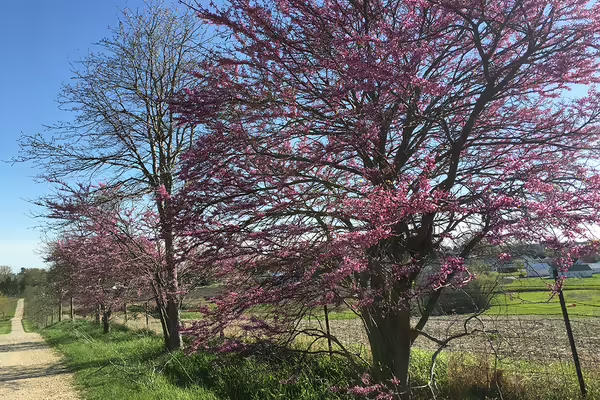
URBANA, Ill. – In a landscape, trees accomplish multiple tasks, from shading our homes to being a home for wildlife. They do everything from providing food to conserving water as well as contributing to our health and community well-being. As trees provide physical, environmental, and emotional benefits, they also help mark the changing seasons around us.
By choosing trees that provide interest across multiple seasons, you can extend your enjoyment and the positive impact made by trees in the landscape. Interest can come in the form of bark, flowers, form, leaves, fall color, fruit, and more.
In the winter, a tree’s form and texture stand out. Often called ‘the bones’ of the landscape, branch structure, pattern, and weight become prominent features. Bark texture is on display as deciduous trees shed their leaves for the winter. The bark becomes a standout feature revealing exfoliating bark, colorful patterns, and unique textures. Many species retain berries that add pops of color to an otherwise monochromatic landscape.
Spring is a time of awakening. As trees begin to break buds, newly emerging leaves can be yellow, orange, or red and eventually give way to shades of green. Trees produce flowers large and small creating a beautiful display for people and a critical food resource for pollinators. In some species, flowers double down on appeal by producing attractive fragrances. Conifers push new growth called candles that come in unique forms and contrasting colors.
Summer trees often blend into the landscape to create a backdrop of rich green hues. During summer months, trees add calm and comfort to many parks and yards. Planting trees with a variety of leaf textures can produce interesting scenes. Spring flowers develop into seeds and berries that decorate trees and feed innumerable species of wildlife as they raise the next generation.
Autumn rounds out the year and in the process of preparing for dormancy, trees produce spectacular displays. Warm hues of reds, oranges, and yellows are on exhibit as chlorophyll subsides, taking with it the appearance of green and blue leaf colors. As the months march toward winter, fruits, berries, cones, and nuts finish ripening. Some turn brilliant hues of red, while others will persist on the plant long after leaves have fallen.
Trees with multi-season interest
Here are a few tree options to consider if you are looking for a new tree with multi-season interest. With the exception of serviceberry, which is a hybrid of two native trees, all of these trees are native species.
- Serviceberry (Amelanchier x grandiflora)
- Redbud (Cercis canadensis)
- River birch (Betula nigra)
- American hornbeam (Carpinus caroliniana)
- Pagoda dogwood (Cornus alternifolia)
- Bald cypress (Taxodium distichum)
Regardless of tree characteristics, it is important to select a tree species that will thrive where you plant it. Before to choosing a tree, conduct a thorough site analysis to better understand the features that will influence tree health and vigor. Choose a tree that is well adapted to those existing site conditions.
For more research-based information on tree care, connect with your local Illinois Extension county office at go.illinois.edu/ExtensionOffice.
Emily Swihart is an Illinois Extension horticulture educator for Henry, Mercer, Rock Island and Stark counties. Gardeners Corner is a quarterly newsletter from gardening experts around the state. Each issue highlights best practices that will make your houseplants, landscape, or garden shine in any season. Join the Gardener’s Corner email list at go.illinois.edu/GCsubscribe for direct access to timely tips.
ABOUT EXTENSION: Illinois Extension leads public outreach for University of Illinois by translating research into action plans that allow Illinois families, businesses, and community leaders to solve problems, make informed decisions, and adapt to changes and opportunities.
Photo: Redbud (Cercis canadensis) trees are one of several trees that can provide multiple seasons of visual interest starting with their pink spring-time blooms. Photo credit: Emily Swihart.
PHOTO ACCESS: The photo in this article is available to download for media use.